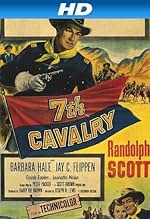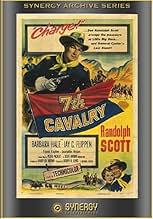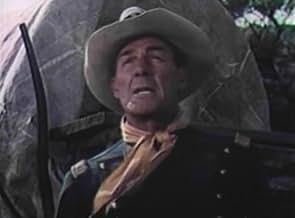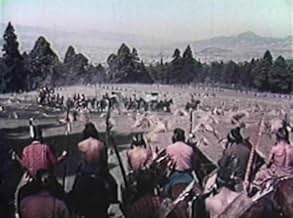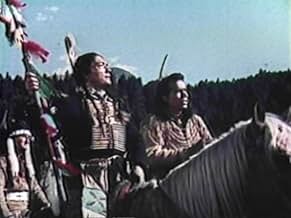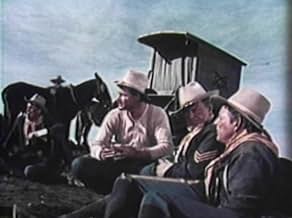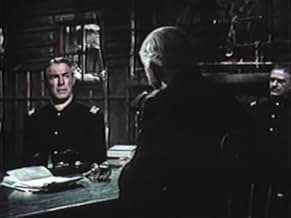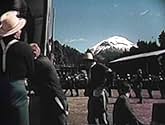VALUTAZIONE IMDb
5,8/10
1497
LA TUA VALUTAZIONE
Aggiungi una trama nella tua linguaAn officer accused of cowardice volunteers to bring back General Custers's body after Little Big Horn.An officer accused of cowardice volunteers to bring back General Custers's body after Little Big Horn.An officer accused of cowardice volunteers to bring back General Custers's body after Little Big Horn.
- Regia
- Sceneggiatura
- Star
Bill Clark
- Soldier With Kellogg
- (non citato nei titoli originali)
Charles Horvath
- Knife-Wielding Indian
- (non citato nei titoli originali)
William Leslie
- Lt. Murray
- (non citato nei titoli originali)
Harold Miller
- Officer at Inquiry
- (non citato nei titoli originali)
Recensioni in evidenza
At 58, Scott was just too old for the role. Not just being only a Captain, but still in cavalry. Not realistic he would have physicality for the activity his character displays.
A very satisfying western with Scott as a cavalry officer who returns with his fiancée to his detail to find the fort apparently deserted. There's a nice 360-degree shot of the surroundings as Scott surveys the area, then he's interrupted by the voice of a woman (Jeannette Nolan) whose claims that Scott is alive at the expense of her husband who took his place in the infamous battle of the Little Big Horn.
The story deals with the aftermath, not the battle itself, so anyone looking for an epic confrontation in the manner of THEY DIED WITH THEIR BOOTS ON or even one as budget conscious as that in THE GREAT SIOUX MASSACRE is bound to be disappointed. However, there are rewards to be found - one of them Scott's performance. Even at about age 57 or 58, he still looks splendid in a uniform, and while of course doubles are used in two fight scenes, there's enough of him present to debunk the rumor that he was not exactly at his best in such scenes. In the inquest scene alone he delivers more dialog than he probably had in his previous three films, and does so convincingly. This scene also features testimony by Captain Benteen and Major Reno, two survivors of the battle who are treated sympathetically.
Director Joseph H. Lewis claimed to not be inspired with the assignment of this film, but he does not let it show. Granted the story may seem slow to start by those who are expecting more than exposition, but here is where we find the first filmic questioning of the judgment of General Custer in what was one of the great military debacles in history. The chase scene in which one comment claims the same stump was passed twice is actually passed three times, once by the Indian brave being chased, next by Scott and then last by two riders following Scott. The scenery is not that of the Montana plains, but it subs nicely. If John Ford can shoot MY DARLING CLEMENTINE in Monument Valley, then Lewis should be allowed his own dramatic license.
The cast is filled with familiar faces, including Michael Pate, Leo Gordon and Harry Carey, Jr., all more recognizable as being part of the Duke's stock company. Add to that Frank Faylen and Jay C. Flippen, as well as Barbara Hale who did deserve more screen time. Just about all are questioning Scott's decision to voluntarily take a patrol to retrieve the dead from the massacre site, but Scott's reasons are to redeem himself for various reasons to each.
A nice touch is in the scene where Scott questions a Sioux "peacemaker" who claims that the bodies, cavalry included, are all now part of sacred ground and instill in each brave the courage and honor of the tribe that conquered them. Scott asks if this is not just mere "superstition" whereas the brave turns the term back at Scott relative to his own spiritual beliefs. This was heady stuff in the mid-fifties when religious epics such as THE ROBE and THE TEN COMMANDMENTS were treated with such reverence. In turn, the appearance of Custer's riderless horse, further takes up the issue of superstition although it would spoil the outcome to reveal just how it does. 7TH CAVALRY is an interesting piece of historical fiction that can take its place among the better non-Boetticher westerns for Scott.
The story deals with the aftermath, not the battle itself, so anyone looking for an epic confrontation in the manner of THEY DIED WITH THEIR BOOTS ON or even one as budget conscious as that in THE GREAT SIOUX MASSACRE is bound to be disappointed. However, there are rewards to be found - one of them Scott's performance. Even at about age 57 or 58, he still looks splendid in a uniform, and while of course doubles are used in two fight scenes, there's enough of him present to debunk the rumor that he was not exactly at his best in such scenes. In the inquest scene alone he delivers more dialog than he probably had in his previous three films, and does so convincingly. This scene also features testimony by Captain Benteen and Major Reno, two survivors of the battle who are treated sympathetically.
Director Joseph H. Lewis claimed to not be inspired with the assignment of this film, but he does not let it show. Granted the story may seem slow to start by those who are expecting more than exposition, but here is where we find the first filmic questioning of the judgment of General Custer in what was one of the great military debacles in history. The chase scene in which one comment claims the same stump was passed twice is actually passed three times, once by the Indian brave being chased, next by Scott and then last by two riders following Scott. The scenery is not that of the Montana plains, but it subs nicely. If John Ford can shoot MY DARLING CLEMENTINE in Monument Valley, then Lewis should be allowed his own dramatic license.
The cast is filled with familiar faces, including Michael Pate, Leo Gordon and Harry Carey, Jr., all more recognizable as being part of the Duke's stock company. Add to that Frank Faylen and Jay C. Flippen, as well as Barbara Hale who did deserve more screen time. Just about all are questioning Scott's decision to voluntarily take a patrol to retrieve the dead from the massacre site, but Scott's reasons are to redeem himself for various reasons to each.
A nice touch is in the scene where Scott questions a Sioux "peacemaker" who claims that the bodies, cavalry included, are all now part of sacred ground and instill in each brave the courage and honor of the tribe that conquered them. Scott asks if this is not just mere "superstition" whereas the brave turns the term back at Scott relative to his own spiritual beliefs. This was heady stuff in the mid-fifties when religious epics such as THE ROBE and THE TEN COMMANDMENTS were treated with such reverence. In turn, the appearance of Custer's riderless horse, further takes up the issue of superstition although it would spoil the outcome to reveal just how it does. 7TH CAVALRY is an interesting piece of historical fiction that can take its place among the better non-Boetticher westerns for Scott.
While George Armstrong Custer was getting massacred at Little Big Horn, Captain Randolph Scott was off wooing and fetching fiancée Barbara Hale, with Custer's permission he says. He escapes court martial, but no one wants anything to do with him. So when it's decided that someone needs to fetch Custer's corpse back - never mind the enlisted men - Scott volunteers to lead the expedition.
It's one of the superb westerns that Scott starred in during the last fifteen years of his movie career, and Joseph H. Lewis directs this with his immensely strong visual style, Technicolor specialist Ray Rennahan shooting from low angles in an ochre-based color matrix. Lots of Strong Men behaving nobly...but is the Comanche idea of nobility the same as the White man's? With Jay C. Flippen, Harry Carey Jr. and Frank Faylen.
It's one of the superb westerns that Scott starred in during the last fifteen years of his movie career, and Joseph H. Lewis directs this with his immensely strong visual style, Technicolor specialist Ray Rennahan shooting from low angles in an ochre-based color matrix. Lots of Strong Men behaving nobly...but is the Comanche idea of nobility the same as the White man's? With Jay C. Flippen, Harry Carey Jr. and Frank Faylen.
Set after the Battle Of Little Big Horn, 7th Cavalry sees Randolph Scott playing Captain Benson, who returns with his future bride to his post commanded by Indian fighter, Colonel Custer. Custer however was gone, he had taken the famous 7th Cavalry to war with the Sioux at Big Horn and lost badly. Guilt ridden and tarnished by whispers of cowardice, Benson volunteers to lead a dangerous mission back to Big Horn to reclaim the bodies of the fallen soldiers.
There doesn't appear to be much much love for this 1956 Columbia Pictures Oater. Seems it's either damned for being too talky, or on the flip side, it's too hokey within its plotting to actually merit worth. Well that's a shame for this has something of a vintage feel to it, the themes of guilt and redemption are Western standards, whilst the story also takes in interesting arcs such as religious beliefs and spiritual meanings. Yes this is definitely a "talky" picture - aside from some mano mano action and single horse pursuits that is - but it's a well thought out screenplay by Peter Packer (adapting from Glendon Swarthout's story). Instances such as a military enquiry and an exchange between Benson and a young Indian warrior are intelligent passages in the story (with Scott doing fine work in the process). What it lacks in gusto action it more than makes up for with the characterisations.
Other plus points are that it's also nicely shot in Mexico, the Technicolor doing justice to the splendid costumes on show. Backing Scott up in support are admirable performers such as Jay C. Flippen, Frank Faylen, Leo Gordon, Michael Pate and Harry Carey Junior. Although the ladies (Jeanette Nolan & Barbara Hale) aren't given too much to do and the score conducted by Mischa Bakaleinikoff is at odds with the tempo of the film, 7th Cavalry still deserves a better reputation than it currently has. If you prepare for a work of fiction that is most assuredly dialogue driven, then hopefully your expectations will at the least be met. 7/10
There doesn't appear to be much much love for this 1956 Columbia Pictures Oater. Seems it's either damned for being too talky, or on the flip side, it's too hokey within its plotting to actually merit worth. Well that's a shame for this has something of a vintage feel to it, the themes of guilt and redemption are Western standards, whilst the story also takes in interesting arcs such as religious beliefs and spiritual meanings. Yes this is definitely a "talky" picture - aside from some mano mano action and single horse pursuits that is - but it's a well thought out screenplay by Peter Packer (adapting from Glendon Swarthout's story). Instances such as a military enquiry and an exchange between Benson and a young Indian warrior are intelligent passages in the story (with Scott doing fine work in the process). What it lacks in gusto action it more than makes up for with the characterisations.
Other plus points are that it's also nicely shot in Mexico, the Technicolor doing justice to the splendid costumes on show. Backing Scott up in support are admirable performers such as Jay C. Flippen, Frank Faylen, Leo Gordon, Michael Pate and Harry Carey Junior. Although the ladies (Jeanette Nolan & Barbara Hale) aren't given too much to do and the score conducted by Mischa Bakaleinikoff is at odds with the tempo of the film, 7th Cavalry still deserves a better reputation than it currently has. If you prepare for a work of fiction that is most assuredly dialogue driven, then hopefully your expectations will at the least be met. 7/10
Captain Benson (Randolph Scott) returns from the east with his new bride-to-be (played ably enough by Barbara Hale) only to find out that his post under General Custer was wiped out at the Battle of the Little Bighorn. The men who were left behind at the post resent Benson because he wasn't there to die gallantly with the rest of his troop.
A presidential order is given for the army to go into Sioux territory and gather up Custer's dead for burial. Benson quickly volunteers for such a dangerous mission, probably to redeem himself. After all, the Big Horn is still surrounded by hostile Sioux and Cheyenne, drunk with victory.
When Benson and his men reach the site, they find that the Indians won't let them un-bury the dead because it is now considered sacred ground and not to be violated. That is, until Custer's riderless horse strolls into view, scaring all the Indians into thinking it's bad medicine and Custer's spirit has returned.
There's a subplot about how this horse came onto the scene involving Harry Carey Jr. and all, but I'm not gonna get into that. Anyway, the Indians are plenty superstitious about the whole thing so they allow Benson and his men to pass, unscathed.
Although it's nowhere near as good as the oaters Scott did with Budd Boetticher, this one nonetheless still rises above most of the other western dreck Harry Cohn and Columbia Pictures was putting out. It also helps filming it out in the California pine country away from the usual Columbia ranch locations that we've seen a zillion times before. It still doesn't pass for the plains, though.
Still, it's better than most of Scott's RKO westerns from the late 40s
5 out of 10
A presidential order is given for the army to go into Sioux territory and gather up Custer's dead for burial. Benson quickly volunteers for such a dangerous mission, probably to redeem himself. After all, the Big Horn is still surrounded by hostile Sioux and Cheyenne, drunk with victory.
When Benson and his men reach the site, they find that the Indians won't let them un-bury the dead because it is now considered sacred ground and not to be violated. That is, until Custer's riderless horse strolls into view, scaring all the Indians into thinking it's bad medicine and Custer's spirit has returned.
There's a subplot about how this horse came onto the scene involving Harry Carey Jr. and all, but I'm not gonna get into that. Anyway, the Indians are plenty superstitious about the whole thing so they allow Benson and his men to pass, unscathed.
Although it's nowhere near as good as the oaters Scott did with Budd Boetticher, this one nonetheless still rises above most of the other western dreck Harry Cohn and Columbia Pictures was putting out. It also helps filming it out in the California pine country away from the usual Columbia ranch locations that we've seen a zillion times before. It still doesn't pass for the plains, though.
Still, it's better than most of Scott's RKO westerns from the late 40s
5 out of 10
Lo sapevi?
- QuizThe surname 'Kellogg' is used for two characters in the film - the colonel and his daughter Martha. It is also the surname of Mark Kellogg, a newspaper reporter who rode with Custer's troops. He was killed at the Battle of the Little Big Horn.
- BlooperAs Corporal Morrison (Harry Carey Jr.) saddles "Dandy", Lt. Col. Custer's second mount, he puts on an English saddle. US Calvary adopted McClellan saddles which remained in service through World War II. This was the wrong saddle for the movie.
- Citazioni
[first lines]
Capt. Tom Benson: We'll be able to see the fort from the top of the next rise.
[Tom and Martha ride a little farther]
Capt. Tom Benson: There she is - Fort Lincoln, the base of the finest cavalry regiment in the country - and our home.
- Curiosità sui creditiOpening credits: Capt. Benson was returning with his future bride, to his post commanded by the gallant Indian fighter Colonel Custer, who had prepared the famous 7th for all out war with the Sioux.
I più visti
Accedi per valutare e creare un elenco di titoli salvati per ottenere consigli personalizzati
- How long is 7th Cavalry?Powered by Alexa
Dettagli
- Tempo di esecuzione1 ora 15 minuti
- Proporzioni
- 1.85 : 1
Contribuisci a questa pagina
Suggerisci una modifica o aggiungi i contenuti mancanti

